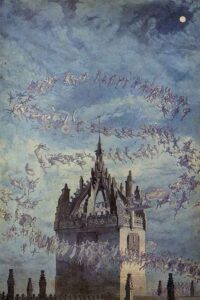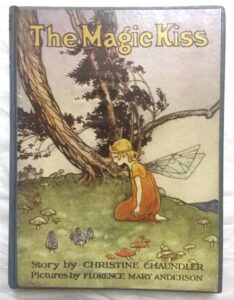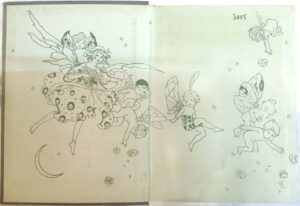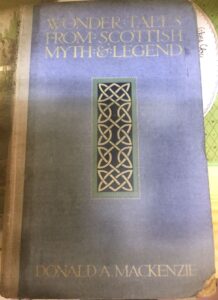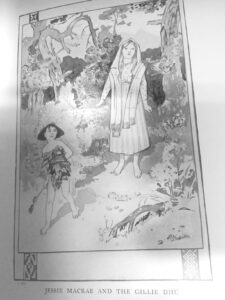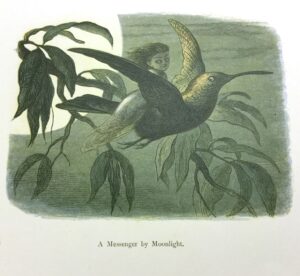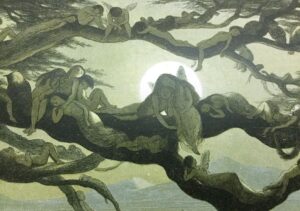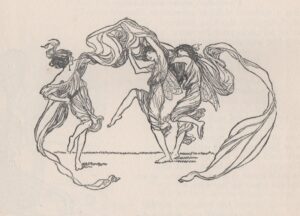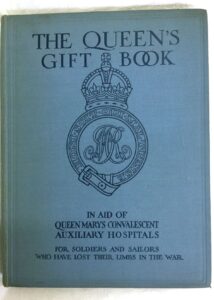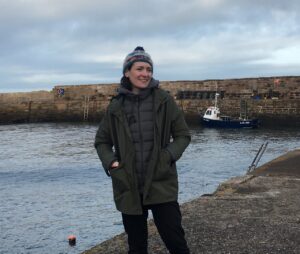In this post, Alice Sage takes us on an intriguing, sumptuously illustrated journey through the outbreaks of fairy fever in Britain after the First World War. Discover how and why fairies created their own pandemic through the astonishing spread of books, art, photographs, and artefacts in this period. Unless otherwise noted, all images of books are taken from items in the collection of the Museum of Childhood, Edinburgh.
*
Our current predicament has drawn attention to the Spanish Flu pandemic that engulfed the world from 1918—1920, but there was another contagion which spread unchecked through Britain in the wake of the First World War: fairy fever.
Fairies were everywhere: in children’s books and plays of course, but also in grown-up poetry, and even newspapers. One stricken theatre reviewer wrote, ‘Now that we no longer believe in fairies, we are vastly interested in what they are like’ (‘Blue Fairies, A Midsummer Nights Dream,’ The Era, 14 November 1923).
The symptoms of fairy fever included fascination, obsession, and a suspension of disbelief. Passion overcame rationality. Sufferers might be seized with inspiration to write fairy poetry and drama, choreograph fairy ballets, or craft elaborate costumes from tulle, tinsel and spangles. These eruptions inevitably spread the contagion.
Some sources identify Sherlock Holmes author Arthur Conan Doyle as ‘patient zero’ for the postwar outbreak, and Carol Silver has blamed his publication of the Cottingley Fairy Photographs in December 1920 for the spread of ‘temporary fairy fever’ (Silver 56). However, Doyle was far from an isolated case. This article offers a brief epidemiology of fairy fever during and after the First World War, using evidence found in the book collection of Edinburgh’s Museum of Childhood and elsewhere.
Population at risk
The long history of fairy fever falls outside this case study, suffice it to say that belief in fairies, trouble with fairies, and real physical harm caused by their enchantments, were an everyday part of life prior to the 19th century.
The Victorians seemed determined to stamp fairies out, through their typical methods of colonisation and confinement. The middle class nursery acted as an isolation ward for fairies — restraining them within children’s stories and poems. Fairies shrank in size, becoming almost as tiny as germs, which had started to appear under the microscope around this same time. Like chicken pox, most people got fairy fever out of their system in childhood.
In adults, though, a preoccupation with fairies could be a serious affliction, especially when combined with other mental and physical illnesses — as in the cases of fairy painters Richard Dadd and Charles Altamont Doyle. In both these cases the obsessions with, and visions of, fairies were presenting symptoms of underlying issues. Dadd’s delusions led him to kill his father, and he spent most of his life painting in secure hospitals; Doyle’s deterioration, usually attributed to alcoholism, saw him resident in a number of Scottish asylums. Both these men left unique records of fairy fever in their artwork.
In less serious cases, if middle-class men could sublimate their fairy fever into their work, they might be hailed as geniuses — see the work of sometime collaborators J. M. Barrie (author of Peter Pan) and illustrator Arthur Rackham. Importantly though, these fairy works were framed as children’s books – even if their darkness appealed to adults too.
Wartime outbreak
A new mutation of fairy fever emerged in wartime London around 1916 — and soldiers were particularly susceptible. Looking back, it seems that the stress of wartime had lowered the population’s defenses. Early signs included stockpiling of fairy images. Estella Canziani’s painting of fairies in a forest glade, Piper of Dreams or Where the Little Things of the Woodland Live Unseen, sold 250,000 reproductions in 1916 — the year that conscription was introduced for British men aged 18-41 (Atkinson, 42).
In May 1916, a charity which sent food parcels to prisoners of war styled themselves as ‘Good Fairies for Unfortunate Fighters’, and described how:
soldiers who have fought and suffered for their country, turn to us, like children, for the one small pleasure they are allowed. Beneath the unromantic string and brown paper covering Parcels for Prisoners lies a whole world of dreams and memories.
(‘Parcels for Prisoners’, The Graphic, 13 May 1916)
Men perceived as childlike, and hope taking the form of an administering fairy? Fairy fever had clearly jumped into the adult population.
Fairy fever spread among packed theatre audiences. Bluebell in Fairyland, a spectacularly frivolous Edwardian pantomime, was revived to great acclaim in the West End. The Old Vic, whose charter was to provide ‘recreation for the working classes’, drew large crowds to fairy-filled productions of A Midsummer Night’s Dream throughout 1916.
Peter Pan (first performed in 1904) was a perennial staple of pantomime season. Soldiers on leave sold out the play’s London performances, and seats were booked months in advance (Purkiss 280). J. M. Barrie’s play promised that children might not die like adults, but instead pass into a fairy-filled Neverland or limbo, from where they might occasionally visit the living. In Peter Pan, death is not final; Peter shouts that ‘to die would be an awfully big adventure’, and several times, characters in the play die and return to life, including the fairy Tinkerbell. During the First World War, this hopefulness resonated with Britain’s conscripted young men and their worried parents.
In a more serious mode — and certainly not intended for children — poet Robert Graves’ Fairies and Fusiliers (1917) promised young men in the ‘soul deadening trenches’, ‘you’ll be fairies soon’. Nicola Bown suggested that fairies could have a cathartic effect for soldiers ‘marooned in the present’, who ‘took to dreaming of, and weeping for, the lost world of fairies’. Was the wartime fairy fever an escapist and nostalgic side-effect of the horrors of conflict?
Fairies continued to thrive in children’s books during the war years, sometimes in escapist forms — for example, The Magic Kiss by Christine Chaunder — but often with a new belligerence. The rather unlikely Navy Book of Fairy Tales (1916) had a foreword by Admiral Jellicoe and included autographs of the Admirals of the Battle of Jutland alongside fairy pictures (The Globe, 11 Dec 1916, p. 3).
The War Fairies by Eleanor Gray (1917) told the tale of two fairy creatures so small they struggle to be seen, yet they’re determined to help in the war effort. In Rose Patry’s Britain’s Defenders, Or Peggy’s Peep into Fairy Land (also 1917), the fairy Queen is named Britannia and she marshals personified elements of wind, sun and rain to defeat the Germans. These publications did not evade the question of the war, but confronted it directly. Fairy fever-dreams were patriotic fantasies in which even the elfin realm pledged allegiance to the British forces.

New local variants developed — such as Donald Mackenzie’s Wonder Tales from Scottish Myth and Legend (1917) — and arrived from overseas.
For Christmas 1916, children were likely to receive Edmund Dulac’s Fairy Book, illustrating ‘fairytales of the allied nations’, including Russia, Italy, Belgium and Serbia. Or perhaps Mabel Lucie Attwell’s Children’s Stories from French Fairy Tales which promised ‘stories of fairyland which are most loved by their French friends and allies’. Attwell had her own particular style of fairy — minute, kewpie-like creatures with antennae, these little bugs crawled over all her illustrations. In the Fairyland compendium (1917), Attwell’s little fairies swarm around Little Red Riding Hood and get under Cinderella’s feet, with little regard for the content of the story.
A photograph in The Sphere in January 1918 showed fairies among soldiers at a London hospital.
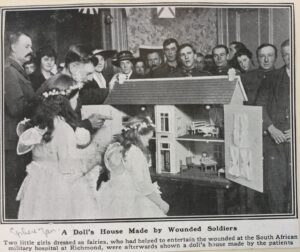
Two fairy-children stand among a big group of adults, including many uniformed soldiers. The fairies are being shown a doll’s house: the ultimate fantasy of tiny, fragile domesticity. The military man’s pointing finger is significant; as the war reached its final months, fairies did indeed return to domestic settings. Rose Fyleman’s bestselling poetry collection Fairies and Chimneys (1918) described fairies in chimney smoke, in motor cars and on Oxford Street buses. Fairy fever had settled on the Home Front.
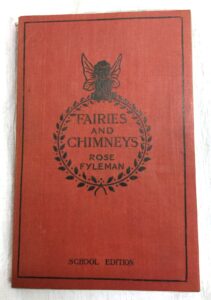
Post-War Years and the Cottingley Fairies
Anyone skeptical about fairy fever could not deny it after December 1920, when the Strand magazine published some now infamous photographs which claimed to prove — for the first time — the existence of fairies. The photos had been taken by two cousins in Yorkshire, Elsie Wright and Frances Griffiths, who claimed that they ‘continually saw fairies in the wood and had come to be on familiar and friendly terms with them’.
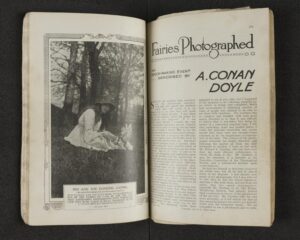
The accompanying article was written by Sir Arthur Conan Doyle, the world-famous creator of Sherlock Holmes, and an evangelist for Spiritualism. Doyle believed that life existed on different planes of vibration, and that fairies (and spirits) lived at a different frequency to humans, which made them invisible. Sometimes, though, fairies might manifest at the margins of perception and become visible to certain gifted humans.
Fairy fever ran in Doyle’s family. I have already mentioned his father, Charles Altamont Doyle, who saw fairies and spirits all around him, first at Blairerno House ‘intemperance’ hospital, and from 1885 at Montrose Asylum.
Charles’s brother, Richard ‘Dicky’ Doyle, also made fairy paintings and books, including his masterpiece of illustration, In Fairyland (1870). When Dicky Doyle died in 1883, his nephew Arthur wrote the poem ‘In Memorium’ (1883), considering the tragedy from the point of view of his beloved fairies:
The little elves upon the walls
Cried, “What is this before us?
“Why should the Master lie so still,
“And why should he ignore us?
“Oh what is this, and why is this?”
They whispered in a chorus.
Details from In Fairyland, written by William Allingham, illustrated by Richard Doyle (1870)
When Arthur Conan Doyle encountered the fairy photographs, he was predisposed to believe them. His long-standing commitment to Spiritualism had redoubled after the death of his son Kingsley in 1918, and any hint of supernatural or post-mortal life gained extra, personal significance. He hoped that the Cottingley Fairy Photographs, would ‘jolt the material twentieth-century mind out of its heavy ruts in the mud, and will make it admit that there is a glamour and a mystery to life’.
Although the Strand article in December 1920 did not start the fairy fever, it might be considered a superspreader event. Doyle’s worldwide fame and reputation attracted huge attention to the Cottingley Fairy Photographs, and he was able to transmit his optimistic fairy fever to many people in the aftermath of the war who shared his hope for glamour and mystery. More fairy sightings were reported. The Shipley Times and Express revealed that a Manningham girl had seen a troop of gnomes pass through a wood where she was, and a Mrs Rose reported that ‘Fairies … constantly congregate in a certain shrubbery at Southend’. The Globe newspaper acceded, ‘we must believe, whether we like it or not’ (‘A Bevy of Fairies’, The Globe, 25 November 1920; the editor had a preview copy of the original Strand article).
There were also many who didn’t share Doyle’s certainty, who were perhaps, immune to fairy fever. ‘Which is the harder of belief, the faking of a photograph or the objective existence of winged being being eighteen inches high?’, wrote Maurice Hewlett in John O’London’s Weekly. Truth magazine labelled the episode ‘an exposition of human credulity in the twentieth century’ — though they happily filled pages of several issues denouncing the believers (Truth Magazine, 9 March 1921 and 12 September 1922). Indeed, the true winners in the debate were the newspapers, who offered analysis of every new detail and printed all the angry letters they could get hold of.

Again, in circumstances which might seem familiar today, believers and sceptics both claimed to have the objective support of ‘science’. Doyle’s Spiritualist language of vibrations, ether and light waves referred to cutting-edge physics, as practiced by his friend, the radio pioneer Oliver Lodge. Scientific seances were carried out at Cottingley Glen by the Society for Psychical Research, and the scientific method was followed in attempts to replicate the photographs.
Decades later, Elsie revealed that the fairies were paper cut-outs, inspired by an illustration in Princess Mary’s Gift Book (1915). Throughout the war, Gift Books had been sold to raise money for a host of charities, and this particular book was a collection of short stories, poems and illustrations by prestigious names — including Arthur Conan Doyle himself — in aid of the Queen’s ‘Work for Women’ Fund. More evidence, if it were needed, that books were a powerful mode of fairy-transmission.
Fairy Fever in Numbers
One way of measuring the growth and spread of post-war fairy fever is through book publishing, using the British Library catalogue. Since the BL is a legal deposit library, collecting every book published in the UK, this data can be used to build a picture of publishing trends.
 This graph shows the number of fairy books published per year between 1901 and 1939 (this is number of different titles, not the total number of copies. Therefore, this measures diversity of the fairy output, not popularity). There is significant variation year on year, but the overall pattern is clear: fairy books were on an upward trajectory in the lead-up to 1914, when numbers slumped sharply. Numbers were low during the war years, and then shot up in 1920 to the highest level on record. The numbers of titles only seriously decreased after 1926, and steadily fell until 1939.[1]
This graph shows the number of fairy books published per year between 1901 and 1939 (this is number of different titles, not the total number of copies. Therefore, this measures diversity of the fairy output, not popularity). There is significant variation year on year, but the overall pattern is clear: fairy books were on an upward trajectory in the lead-up to 1914, when numbers slumped sharply. Numbers were low during the war years, and then shot up in 1920 to the highest level on record. The numbers of titles only seriously decreased after 1926, and steadily fell until 1939.[1]
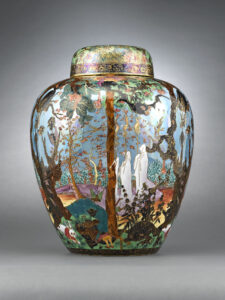
The wartime slump affected all forms of publishing, and we must not forget that many fairy books were repackaged as ‘gift books’ during those years. Over 350 fairy books were published during that peak of 1920—25, demonstrating how publishers responded to the post-war appetite for fairy poems and stories, old and new. A large proportion of these books were intended for children, but we must remember that it is adults who write, illustrate and publish books — and adults, therefore, who transmitted fairy fever.
It was certainly adults who bought other fairy-related products, for example Wedgwood’s indulgent fairy lustreware, designed by Daisy Maekig-Jones. The series had launched in 1915 but reached peak popularity in the early-1920s.
The books published in those feverish years included Doyle’s The Coming of the Fairies (1922), in which he wrote that fairies, ‘may have their shadows and trials as we have, but at least there is a great gladness manifest in this demonstration of their life’. New authors included Enid Blyton, whose book of poems, Real Fairies came out in 1923, followed by The Enid Blyton Book of Fairies in 1924. Cicely Mary Barker’s first book, Flower Fairies of the Spring (1923), captured the mournful optimism of the time:
The World is very old,
And sometimes sad;
But when the daisies come
The World is glad.
The World is very old;
But every Spring
It grows young again,
And fairies sing.
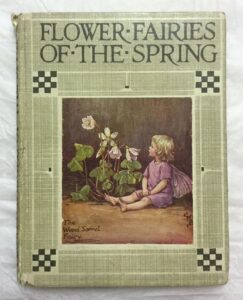
Ruth Fyleman’s Fairies and Chimneys reached twenty editions by the end of 1925, including a school edition every year from 1920 to 1925 — ensuring that every child was exposed to fairy fever. The Edinburgh publishing house Nelson brought out new illustrated of old stories, the Andrew Lang coloured fairy books came in new editions, and the Grimms’ and Hans Christian Andersen were ‘retold’, ‘adapted’ and ‘selected’.
But as reflected in the graph, eventually the fever broke, and many adults awoke from their fairy fever-dreams. No more fairies could be seen in Cottingley, or anywhere else. The reason for their disappearance was as mysterious as their emergence. Some blamed modern education. Other more scientific minds regretted that ‘a seam of coal had been found in the fairy glen, and it had been greatly polluted by human magnetism’.
By the end of the 1920s, fairy fever had ceased to be such a concern. It lingered, of course, in the tiny creations of Mabel Lucie Atwell, Ida Rentoul Outhwaite, and the succession of women illustrators who produced children’s books between the wars.
In 1944, the Yorkshire Post looked back on the Cottingley Fairy episode, and sighed, ‘it was fun while it lasted’.
*
[1] Data from searches of the BL catalogue for titles including the words fairies or fairy* (which would include fairyland, fairytale etc).
References
Maggie Atkinson, ‘Visions of “Blighty”: Fairies, War and Fragile Spaces,’ Libri & Liberi 6, no. 1 (2017)
Nicola Bown, Fairies in Nineteenth Century-Art and Literature (Cambridge: Cambridge University Press, 2008)
Diane Purkiss, Troublesome Things: A History of Fairies and Fairy Stories (Penguin, 2001)
Carole G. Silver, Strange and Secret Peoples: Fairies and Victorian Consciousness (Oxford: Oxford University Press, 1999)
Alice Sage is a cultural historian, interested in fantasy and feminism. She has made exhibitions about dolls’ houses, bedtime stories, quilts and the Clangers, and has a small press, Wide Open Sea, publishing art and writing from interesting, wild women. She’s just finishing her PhD investigating children’s performance in the 1920s and is open to new collaborations. alice.emma.sage@gmail.com
(Marion Wallace-Dunlop)


